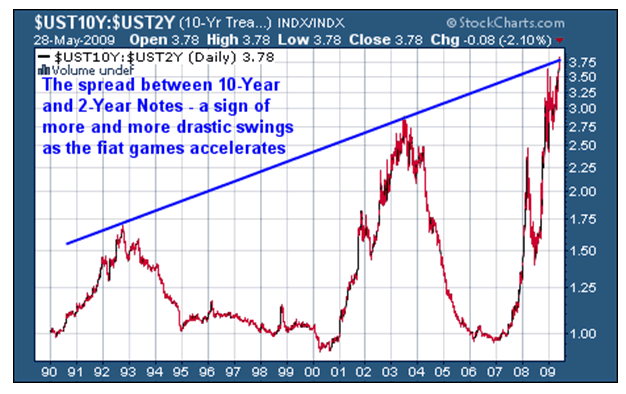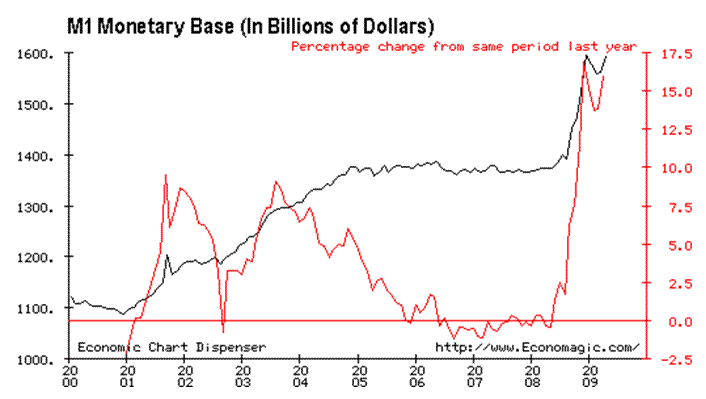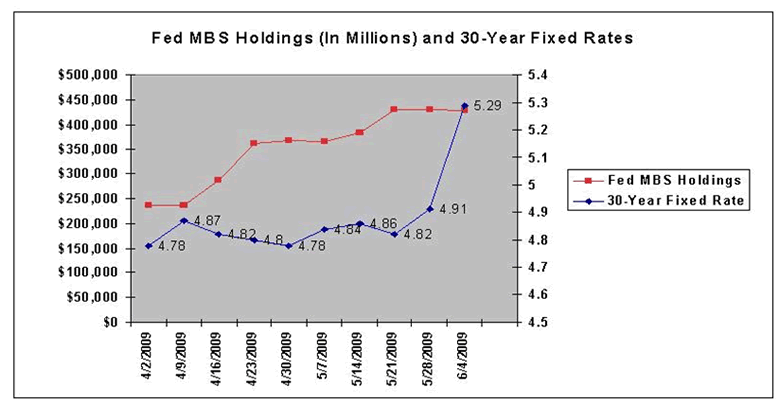U.S. Fed Throttling the Economic Recovery?
Economics / US Interest Rates Jun 05, 2009 - 01:28 PM GMTBy: Andy_Sutton
 Despite the calm appearance on the economic waters of late, there is quite a bit of turbulence building beneath the surface on a multitude of fronts. Several developments have emerged that fly directly in the face of the idea that we’re headed for a green shoots recovery. Even more surprising, when you take a deeper look at these issues, some rather remarkable inconsistencies emerge in that the methods being used in some critical areas virtually guarantee that they will not be successful. We’ll take a look at two of these areas, but first, let’s discuss manoeuvring room.
Despite the calm appearance on the economic waters of late, there is quite a bit of turbulence building beneath the surface on a multitude of fronts. Several developments have emerged that fly directly in the face of the idea that we’re headed for a green shoots recovery. Even more surprising, when you take a deeper look at these issues, some rather remarkable inconsistencies emerge in that the methods being used in some critical areas virtually guarantee that they will not be successful. We’ll take a look at two of these areas, but first, let’s discuss manoeuvring room.
A compressing timeline – less time for proactivity
Last week we presented a chart of the spread between 10 year and 2 year bonds and noted how with each interest rate ‘cycle’ that the spread is getting bigger. For reference, that chart is included below.

What is perhaps even more alarming than the increasing spread with each successive cycle is that the timelines are becoming compressed meaning that there is less time for recovery with each subsequent cycle. Such as has been the case in many other fiat systems when they begin to degrade. Volatility increases while the business cycle compresses. This is exactly what we’re seeing here. Firms and cohorts become reactive rather than proactive and it seems they’re always a day late and a dollar short. Not only do they have limited time to properly position for the next cycle, but with each subsequent cycle, they emerge with diminished resources as well.
No Green Shoots for Consumers?
Consumers are not far behind in this regard. As consumer prices continue to be on the increase due to the recent blowout in the monetary base (M1), expectations will switch from deflationary to inflationary.

However, there is a problem in this regard; the fuel for this inflation is not present. In order to see a meaningful inflation at the consumer level, money or credit has to find its way into the hands of consumers to monetize demand. Wages have been remarkably stagnant, with the most recent data suggesting that wages are increasing at a 1.2% annual rate. Consumer credit, which is another potential source of spending money, has been in a contractionary pattern over the past 4-6 months.
Fiscal stimulus by the federal government has largely left consumers out of the picture as the government has opted to try to initiate consumers to spend their own money instead of monetizing demand directly through rebates or other types of transfer payments. The shift from the direct stimulus method, which was used at the beginning of 2008 to the indirect method of using tax credits, has been important. Ostensibly, from a financial perspective it doesn’t really matter which means are used. The government will either spend money directly or lower future tax receipts as people take advantage of the credits.
The message here is clear. The government would prefer that people didn’t save, opting rather to borrow and consume in the present and avail themselves of a tax credit at the end of the year.
This is evidenced by the ever-growing list of tax credits that are available for doing various things like buying a home, putting in alternative energy systems, or installing energy saving devices. The problem is that in order to take advantage, consumers must have access to the money and/or credit to make the expenditure in the first place. This is probably the worst way to stimulate consumption in a cohort that is already grossly overextended. Consumers, to a certain degree have sniffed this out as is evidenced by increased savings rate in recent months. Job losses haven’t helped to encourage spending and certainly won’t do much for consumers’ willingness to borrow. If the government was interested purely in consumption, there are much better ways to stimulate it.
It would seem possible that there are some ulterior motives at work here. Namely that the government would prefer that consumption remain tepid or even contract without them actually coming out and saying it. More on this a bit later.
Mortgage bond yields continue to rise
The Federal Reserve publicly plans to purchase $1.25 Trillion in mortgage bonds this year alone in an effort to keep mortgage rates down. However, rates have shot up from just under 4.8% to nearly 5.5% in just the past few weeks. One would wonder what exactly is going on here. How can this be, given that the Fed has pledged its undying support to this market? It would appear they have, at least for the meantime, reneged on their pledge. Consider the following:
As of April 30th, the Fed held a total of $367.728 Billion in mortgage backed securities. That number increased to $384.115 Billion on 5/14, $430.485 Billion on 5/21, and reached a peak of $430.902 Billion on 5/28. However, as of yesterday, Fed holdings of MBS actually fell to $427.612 Billion, meaning the Fed sold over $3 Billion of MBS during the past week.
So not only has the Fed slowed its support of this endeavor in the weeks leading up to 5/28, they are now contributing to higher mortgage rates by selling into an already weak market. I would contend that they never should have been buying MBS in the first place, but since they decided to monetize this market, why all of a sudden are they content to allow rates to jump nearly 15% in two weeks by withdrawing their support? Every piece of Fed testimony would lead one to believe they firmly attach the success of the housing market to the success of the overall economy. So why pull the plug on that support just when there seemed to be at least something of a bottom forming? No doubt the quick increase in rates will scare buyers away. A three quarter percent increase in rates will quickly eat up any tax credit the government is providing.

Again, similar to the issue with consumers, it would seem as though there is an attempt being made to throttle recovery without coming right out and admitting it.
One possible answer - The $100 Trillion consumption gap?
It has long been the view of this weekly editorial that our climbing debt levels would eventually be what sank the US as the premier economic world superpower. Even more than the debt itself is the impact such debt will have on future generations. Unfortunately, this is one angle that is rarely looked at. Most government reports reflect the national debt, trade, and budget deficits as a percentage of GDP. Using this measure, it is easy to look at the debt picture of the US in a rosy light. On a purely percentage basis, the debt looks manageable and is not out of line with other industrialized nations. The problem lies in the ability of both the economy, and the working class young to repay the debt. In other words, we never look at the impact of the debt, but rather choose focus on the size of it.
When one starts to examine the impact of our mounting debt and take into account generational and demographic factors affecting our population, it becomes immediately clear that not only is our current standard of living unsustainable, but it is downright foolish to expect that it can continue. This week on our Spin Cycle podcast, we talked with Professor Laurence Kotlikoff who can easily be considered an expert in the field of generational accounting. He pointed out during our discussion that there was more than a $100 Trillion gap between our ability to produce, and our appetite for consumption. Such studies are stretched out over many years with the future dollars being discounted to the present so we can compare apples with apples.
Certainly those in the upper levels of government and finance are aware of these realities and realize that there is simply no way we can continue to consume at our present rate, enjoy the same standard of living, and ever have any hope of paying for it without a massive hyperinflation and the resultant economic and social discord. Another contributing factor in this analysis is the growing likelihood that not only has global oil production peaked, but that our ability to procure ever-increasing amounts of other materials necessary for our standard of living has peaked along with it.
For more information about generational accounting and our current fiscal and consumption gap, listen to our interview with Professor Laurence Kotlikoff by visiting our podcast page: www.my2centsonline.com/radioshow.php and looking in the ‘Spin Cycle’ section. Next week we’ll conclude our cubic analysis with a discussion of energy and natural resources with Zapata George Blake. That podcast will be available on 6/10/2009 and may also be found at the above link under the same section.
By Andy Sutton
http://www.my2centsonline.com
Andy Sutton holds a MBA with Honors in Economics from Moravian College and is a member of Omicron Delta Epsilon International Honor Society in Economics. His firm, Sutton & Associates, LLC currently provides financial planning services to a growing book of clients using a conservative approach aimed at accumulating high quality, income producing assets while providing protection against a falling dollar. For more information visit www.suttonfinance.net
Andy Sutton Archive |
© 2005-2022 http://www.MarketOracle.co.uk - The Market Oracle is a FREE Daily Financial Markets Analysis & Forecasting online publication.



